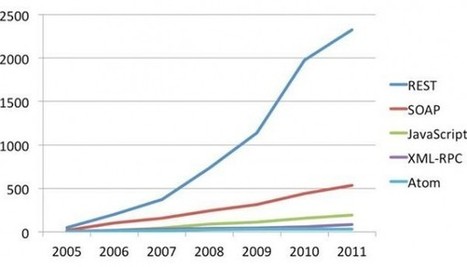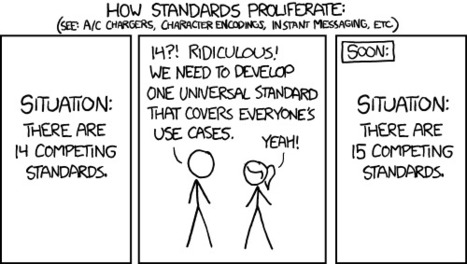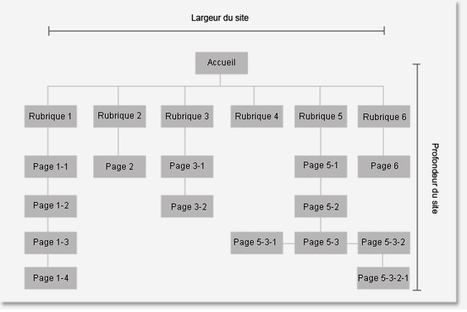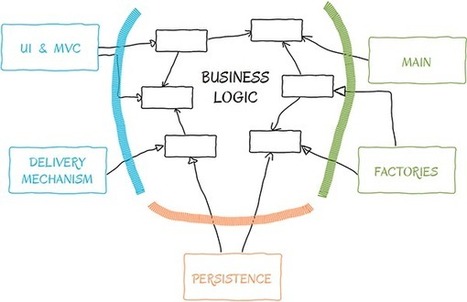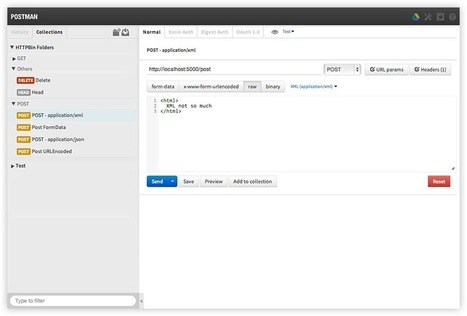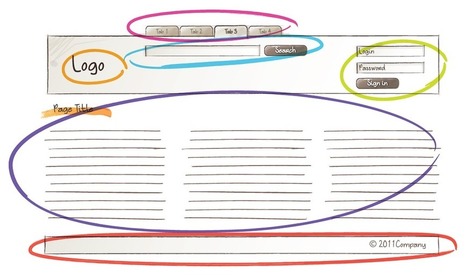 Your new post is loading...
 Your new post is loading...

|
Rescooped by
Mickael Ruau
from Dev Breakthroughs
December 31, 2013 5:06 AM
|
The digital world is expanding at an amazing rate, giving us access to applications and content on myriad connected devices in your homes, offices, cars, pockets and on even on your body. The glue that allows all of this to happen, that connect the companies who provide these services to the devices that you use, is the API. Because APIs have such a huge responsibility for so many people and companies, it is natural that API design is often one of the industry’s liveliest discussions, touching on a range of topics including resource modeling, payload format, how to version the system, and security. While these are likely important areas to explore when designing virtually any API, the reality is that a much larger decision needs to be made first. That decision is based on a fundamental question: who are the primary audiences for this API and how can we optimize for those audiences? This seems like an innocuous enough question, but don’t underestimate its importance or complexity in the growing world of APIs.
Via Nicolas Weil

|
Scooped by
Mickael Ruau
December 22, 2013 5:41 AM
|
Comment vous le savez peut être, DotnetDojo a pour objectif d’aider les développeurs à améliorer leurs capacités. J’ai donc préparé un document qui exprime ces idées sous la forme de 18 grands principes.

|
Scooped by
Mickael Ruau
December 21, 2013 7:04 AM
|
The adoption of REST as the predominant method to build public APIs has over-shadowed any other API technology or approach in recent years. Although several alternatives (mainly SOAP) are still (very) prevalent in the enterprise, the early adopters of the API movement have taken a definitive stance against them and opted for REST as their approach and JSON as their preferred message format. All this for good reasons: SOAP/WSDL is overly complex in most cases and difficult to consume from thin clients.The REST architectural style fits well with HTTP and the scalability, caching and distribution best practices prevalent in large-scale web and mobile applications.The common use of JSON within REST APIs makes them extremely easy to consume from scripting-based platforms (web/Ajax, node.js, grails, etc.)
Read more: http://blog.programmableweb.com/2013/12/19/is-rest-losing-its-flair-rest-api-alternatives-2/#ixzz2o6taIREi ;
Follow us: @programmableweb on Twitter | ProgrammableWeb on Facebook

|
Scooped by
Mickael Ruau
December 16, 2013 8:34 AM
|
Je vais vous faire une confidence, je suis un véritable obsédé. Dans tous mes projets, j’y pense tout le temps, et la plupart de mes décisions de code, de design et d’architecture sont influencées par cette obsession. Vous l’avez deviné, mon obsession tourne autour des dépendances entre les éléments du code, et je pense que vous y êtes sensibles aussi !

|
Scooped by
Mickael Ruau
December 13, 2013 2:44 AM
|
When you’re designing, testing, or releasing a new Web API, you’re building a new system on top of an existing complex and sophisticated system. At a minimum, you’re building upon HTTP, which is built upon TCP/IP, which is built upon a series of tubes. You’re also building upon a web server, an application framework, and maybe an API framework. Most people, myself included, are not aware of all the intricacies and nuances of every component they’re building upon. Even if you deeply understand each component, it’s probably going to be too much information to hold in your head at one time.

|
Scooped by
Mickael Ruau
November 29, 2013 10:12 AM
|
This post is a written transposition of the talk I gave at Nantes' JUG on November 4th 2013. Since it took place in France, this article is in French. Ce post est une transposition écrite de ma pré...

|
Scooped by
Mickael Ruau
November 23, 2013 9:14 AM
|
Les systèmes techniques doivent en permanence être corrélés avec les systèmes sociaux.

|
Scooped by
Mickael Ruau
November 20, 2013 10:25 AM
|
Si vous êtes versés dans le monde PHP, il y a quelques chances que vous ayez entendu parler de la norme PSR-0. Par contre, les normes PSR-1 et PSR-2 sont plus récentes, et de fait moins connues. Ces normes sont définies par le « PHP Framework Interoperability Group » (FIG en abrégé), un groupe d’acteurs connus du monde PHP, contributeurs de frameworks, ORM et bibliothèques parmi les plus connus. Tout ce petit monde s’est réuni pour tenter de définir un ensemble de règles communes, afin de faciliter l’utilisation de différentes briques logicielles écrites en PHP.
Vieux comme l'informatique, ou presque, le métier d'architecte IT version 2013 vit à l'heure de l'acronyme SMAC (Social, Mobile, Analytics et Cloud).
Via Christophe Demulder, Duarte Terencio

|
Scooped by
Mickael Ruau
November 16, 2013 5:38 PM
|
Une RESTful ArchitectureCommunauté .NET Montréal

|
Scooped by
Mickael Ruau
November 16, 2013 10:59 AM
|
Construire l'arborescence d'un site web se fait une fois tous les contenus listés, organisés et structurés.

|
Scooped by
Mickael Ruau
November 16, 2013 10:46 AM
|
HATEOAS, an abbreviation for Hypermedia as the Engine of Application State, is a constraint of the REST application architecture that distinguishes it from most other network application architectures. The principle is that a client interacts with a network application entirely through hypermedia provided dynamically by application servers.

|
Scooped by
Mickael Ruau
November 16, 2013 10:40 AM
|
Introduction au style d'architecture REST qui a servi de modèle à l'architecture de l'Internet et aux sites les plus efficaces de l'Internet.
|

|
Scooped by
Mickael Ruau
December 27, 2013 5:19 AM
|
L’urbanisation touche tous les niveaux de l’organisation. Pour mener à bien cette démarche, et assurer l’alignement des transformations du SI avec le métier, sa stratégie, ses besoins et ses contraintes, quelques étapes incontournables doivent être respectées autour de ses différentes dimensions (métier, fonctionnelle, applicative et technique). Le but : recenser et capitaliser l'ensemble des informations disponibles sur le SI de l'entreprise (bases de données, applications, services, etc.), en relation avec leur fonction, afin de les rationnaliser et de valoriser le capital informationnel de l'entreprise. • Dimension métier : positionnement des métiers (étude des différents secteurs fonctionnels de l’entreprise : production, administration, ventes…), cartographie et analyse des processus métier de l’organisation.
• Dimension fonctionnelle : positionnement des fonctionnalités offertes par le SI pour supporter les processus métier.
• Dimension applicative : description de l’ensemble des éléments du système informatique implémentant les services urbanisés sous forme d’éléments logiciels.
• Dimension technique : description de l’infrastructure de fonctionnement des éléments logiciels du système informatique.

|
Scooped by
Mickael Ruau
December 21, 2013 7:06 AM
|
Imperative programming is in my bloodstream. I’ve been a C++ programmer for most of my life. I wrote a book about C++. I helped Andrei and Walter design an imperative language D. If I dabbled in functional programming, it was mostly to make my imperative programs better.

|
Scooped by
Mickael Ruau
December 18, 2013 3:20 AM
|
These constraints are intended to be excessively restrictive, so as to force developers out of the procedural groove. I guarantee if you apply this technique, their code will move markedly towards object orientation.

|
Scooped by
Mickael Ruau
December 14, 2013 8:44 AM
|
Single Responsibility (SRP), Open/Close, Liskov’s Substitution, Interface Segregation, and Dependency Inversion. Five agile principles that should guide you every time you write code.

|
Scooped by
Mickael Ruau
December 13, 2013 2:44 AM
|
Postman is a powerful HTTP client to help test web services easily and efficiently. Postman let's you craft simple as well as complex HTTP requests quickly. It also saves requests for future use so that you never have to repeat your keystrokes ever again. Postman is designed to save you and your team tons of time. Check out more features below or just install from the Chrome Web Store to get started.

|
Scooped by
Mickael Ruau
November 29, 2013 9:51 AM
|
Definitions of BEM methodology.

|
Scooped by
Mickael Ruau
November 23, 2013 9:12 AM
|
By Xavier Perrin (xperrin@xp-consulting.fr)
The lean approach, often discussed in this blog, is now considered essential for our companies’ competitiveness. At the same time, this approach is becoming more and more criticized.

|
Scooped by
Mickael Ruau
November 19, 2013 4:46 PM
|
At POP, our site is entirely API driven. We separated our frontend codebase from our backend API in it’s entirety. The two sites are even in separate repositories. There are several reasons we decided to use this architecture which I’ll cover below.

|
Scooped by
Mickael Ruau
November 16, 2013 5:39 PM
|
OAuth and REST web services Portland Java User Group Portland, Oregon March 17 2009

|
Scooped by
Mickael Ruau
November 16, 2013 5:36 PM
|
SlideShare is the world’s largest community for sharing presentations. Discover great content and connect with like-minded individuals.

|
Scooped by
Mickael Ruau
November 16, 2013 10:48 AM
|
Tous les conseils du journal du Net sur l'architecture Web : définition, actualité, conseils, retours d'expérience, avis d'expert.

|
Scooped by
Mickael Ruau
November 16, 2013 10:40 AM
|
REST ( REpresentational State Transfer ) est un style d' architecture pour les systèmes hypermédia distribués, créé par Roy Fielding en 2000 dans le chapitre 5 de sa thèse de doctorat. REST n'est pas un protocole (tel que HTTP) ou un format.
|



 Your new post is loading...
Your new post is loading...




